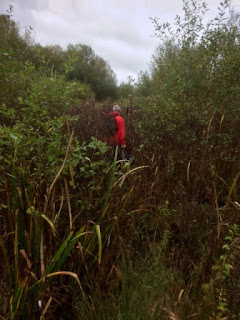By ‘C’:
You know the
weather has been spookily warm when one of these appears, in the space of one
morning in late October, in the middle of your lawn …
 |
| Common/Corn/Flanders Poppy (Papaver rhoeas) |
one of these
lands on your bathroom window (but sadly didn’t stay long enough to have its
portrait better taken):
 |
| Red Admiral (Vanessa atalanta) |
and that
same afternoon a very confused bumblebee
almost the size of a small bat literally flies into you as you are sitting at
your desk. Honest! Body length must have been at least 25 mm. A queen Bombus terrestris? Or the rare Ruderal bumblebee? Very hard to tell as this one was melanic –
and my attention was focussed on trying to help the creature back outside. (Hence no photo at all; now ain’t that a shame.) For
comparison, a mature Pipistrelle Bat comes in at 35 mm.
There was
even a possibility that Green Gym itself might have gone to the dogs
today. Our wonderful Tools Officer gave
notice that he might find himself running late: something complicated about a
canine play-date …
All,
however, turned out well. The site-warden
would have had enough equipment for us to get started happily enough. As it happened, our own tools arrived in good
time – our Tools Officer said he had picked out “the dirty forks” …
because in
the stream they get cleaned better. And
in any event, today’s undertaking was one which can be tackled with plain
(gloved) hands. For after last week’s
winter-time job, today we – augmented by volunteers from the nearby air station
– were deployed on a task we normally associate with summer: pulling excess
watercress to keep channels clear for the Chilterns chalk stream.
Actually,
the first phase of the operation consisted of slashing nettles on the
bank.
Or we’d have had nowhere to put the
piles of excess watercress.
Also the
work did not consist entirely of disposing of watercress. There was some riparian willow and to trim
back as well – and dispose of. Transporting
brash at Green Gym mostly means carrying it.
In this case, from the place where it had been cut …
over a wall …
and across the
bridge (with the observation “Heavy plant crossing!” when the larger loads were
being moved):
Then it was
decided the first place it had been moved to, was perhaps not the best:
So more
carrying …
to the processing
area, where the unwanted species (ash) and the spoil from the desirable species
(willow) could be thrown directly on to the compost heap:
There the
good willow was turned into neat bundles of rods. Of which this, it was decided, was the
neatest:
Meanwhile,
the watercress-channel clearing continued.
This is hard work, so tea-break – with a welcome range of goodies, some
sweet, some savoury, some seasonal – was most welcome:
After the
break, the focus was mostly on transporting again. This time, piles of watercress from the concrete
bund (where at least some of the water had dripped out) to the bank:
Oh and there
was the area around “the kingfisher post” to clear – so that the kingfisher has
somewhere to perch:
How will the
kingfisher know that this is a kingfisher post?
Green-Gym answer: Because the kingfisher reads the blog!
All this
with a hefty RAF presence. Not just in
the form of RAF manpower assisting us on the ground (and in the water). But also RAF in the skies above us, and
providing an acoustic & aromatic accompaniment from the runways:
At last, it was tidying-up and collecting-tools time. The willow bundles were stacked with their feet in the water to keep them alive and well until they are used:
With all
that extra muscle power and dedication behind Green Gym this morning, a more
than good job had been done:
 |
| Before |
 |
| Just putting the finishing touches |







































